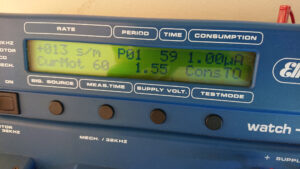One of the most common jobs in the world of watch repair is replacing the battery. It’s important to have your watch battery replaced by someone who knows what they’re doing for a numerous reasons – Many of which we’ve covered in previous blog posts. But what exactly do we do during a battery change? This blog post will aim to tell you just that.
The first thing we do with any watch we receive is to take photos of it, before thoroughly checking the watch over. We check the condition of the case and strap/bracelet for any damage/functionality, before then checking the functionality of the watch. We check if the watch is working, can the hands can be set, if the date can be changed and so on. These checks are important as they help with diagnosing faults which may have slipped the attention of our client. For example a chronograph watch may be sent in for a simple battery change, but we find the chronograph doesn’t work.
Assuming all is well, we can proceed. The first thing to do is to remove the strap. These are usually held on by spring bars, though straps can be screwed in place, or be attached to the case via rivets. Once this is done, If the watch is dirty, we use a brush to remove as much of the dirt as possible. We encourage our clients to try and keep their watches clean – dirt can cause problems with seals and get underneath the crown (and/or chronograph pushers if you have a chronograph watch). This ends up causing parts to fail and can lead to additional work being needed. Dirt is removed prior to opening the case back, as it’d be problematic to allow dirt to enter the case. Quartz watches need spotlessly clean movements to function correctly. It only takes one small particle of dirt in the wrong place to stop the watch completely.

Next we can remove the case back. Watch case backs come in all different shapes and sizes. The most common types of fitting are snap on case backs – where the back is press-fitted onto the case. There are screw-on case backs, where the case back is threaded and screws onto the case. A case back may also be held in place by tiny screws. It’s important to have the correct tools and knowledge to remove the case back, otherwise it’s highly likely the case back will be damaged during removal.
We can now see the movement itself. There are literally thousands of different types of quartz movement, and the battery removal procedure will be slightly different for each one, though some general rules remain the same. Fingers shouldn’t be anywhere near the watch movement (again, cleanliness). The battery is removed using plastic (or equivalent coated) tweezers. Depending on the type and condition of the movement, we may now use our quartz movement testing machine to test the watch to ensure the movement is working within the manufacturer’s specifications. This is a specialist piece of equipment – another reason why taking your watch to a specialist watchmaker is important – we provide a comprehensive service. It’s also important the battery being fitted is the correct type! This may sound silly, but you’d be amazed how often we find an incorrect battery fitted to a watch. An incorrect battery, or one of the correct size but from a sub-standard manufacturer, won’t last for as long as it should and may drain quicker or in extreme examples leak.
We use quality Swiss Made watch batteries and fit the correct type for the movement. These are carefully fitted using plastic tweezers. With the case back off we can inspect the back seal in case this needs replacing too. After the battery is carefully fitted, the movement is given a final inspection before the case back can go on. Alignment is important – there may be a cut out for the stem to work properly, or text may need to be up the right way. In some situations we need to use a press to fit stubborn snap-on case backs. Threaded case backs are removed and refitted using a specialist sturdy bench case back remover.
With the back fitted we can refit the watch strap. If the spring bars holding the strap in place are worn, these are replaced. Finally we can set the time and date. Job done!
The above procedure is a very simplistic outline and we tailor our work around the watch in question. Bear in mind, we haven’t even discussed procedures around water resistant models or unusual watches, like the Jaeger Le Coultre Reverso, or one-piece case watches, where the glass needs to be removed during a battery change. You can rest assured we follow industry standard best practices and aim to provide one of the most comprehensive watch repair services in the UK, with trained watchmakers and specialist brand tooling suitable for brands like Omega, Breitling and Tag Heuer in our fully equipped workshop.
Do you have a watch in need of a new battery? We are able to repair almost any watch and we offer a comprehensive watch repair service. We cater to clients all around the UK thanks to our fully insured freepost watch repairs service. As Business Partners of the British Horological Institute and a Feefo Platinum Trusted Service Award accredited business, you can be confident when dealing with us. Contact us today and see how we can help.
Yours sincerely
David Clark DGA PJDip PJGemDip CertGA
Managing Director
W.E. Clark & Son Limited
